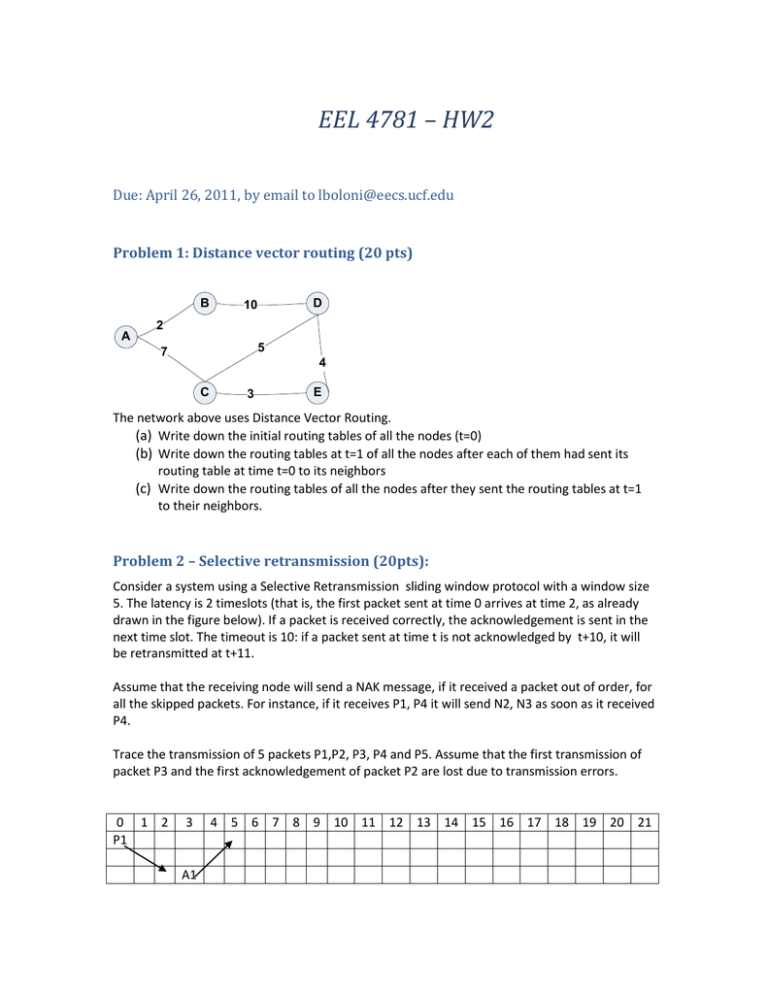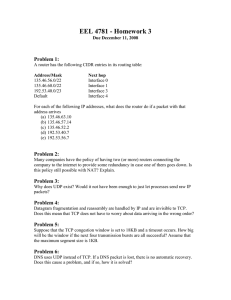EEL 4781 – HW2 Due: April 26, 2011, by email to
advertisement

EEL 4781 – HW2 Due: April 26, 2011, by email to lboloni@eecs.ucf.edu Problem 1: Distance vector routing (20 pts) B A D 10 2 5 7 4 C 3 E The network above uses Distance Vector Routing. (a) Write down the initial routing tables of all the nodes (t=0) (b) Write down the routing tables at t=1 of all the nodes after each of them had sent its routing table at time t=0 to its neighbors (c) Write down the routing tables of all the nodes after they sent the routing tables at t=1 to their neighbors. Problem 2 – Selective retransmission (20pts): Consider a system using a Selective Retransmission sliding window protocol with a window size 5. The latency is 2 timeslots (that is, the first packet sent at time 0 arrives at time 2, as already drawn in the figure below). If a packet is received correctly, the acknowledgement is sent in the next time slot. The timeout is 10: if a packet sent at time t is not acknowledged by t+10, it will be retransmitted at t+11. Assume that the receiving node will send a NAK message, if it received a packet out of order, for all the skipped packets. For instance, if it receives P1, P4 it will send N2, N3 as soon as it received P4. Trace the transmission of 5 packets P1,P2, P3, P4 and P5. Assume that the first transmission of packet P3 and the first acknowledgement of packet P2 are lost due to transmission errors. 0 1 2 P1 3 A1 4 5 6 7 8 9 10 11 12 13 14 15 16 17 18 19 20 21 Problem 3: Application layer (20pts) (a) Outline a way to steal somebody's private data if you can tamper with his DNS server. (b) Multiple DNS names can map to the same IP address (yes / no / discuss) (c) Multiple IP addresses can map to the same DNS name (yes / no / discuss) (d) Explain the difference between server side and client side processing in web applications. Give examples for applications which do one, the other or both. (Give the name of the service and explain why it is so). Problem 4: TCP and UDP (20 pts) (a) Explain the silly window syndrome in three short sentences. (b) Let us assume that UDP has never been invented. Describe an approach which would allow you to emulate the behavior of the UDP with TCP, while still conforming to the standard TCP behavior on the wire. Discuss what you can and what you cannot emulate. Problem 5: TCP congestion control (20pts) Suppose that for a TCP connection, the maximum segment size is 1KB (this is the smallest size of the congestion window). Currently the TCP congestion window is set to 23KB and the threshold is 5KB. Trace the size of the congestion window and the threshold for the following sequence of events: timeout, success, success, success, success, success, succcess, timeout Problem 6: Medium access control (20pts) PassThePenny is a local area network protocol, similar in purpose to Ethernet, but based on different principles of mediating access to the bus. To mediate access to the bus, PassThePenny uses a penny passing scheme. When peers are inactive, a single penny message is passed around the network from machine to machine, and no peer is allowed to use the bus unless it has the penny. If a particular peer wishes to send a message, it waits to receive the penny and sends the message instead. The receiving node will pass the penny back to the sender. If a node has the penny but doesn’t want to send, it sends the penny to the next station. (a) The PassThePenny algorithm can be used with very small packets and on very long cables. Ethernet has a minimum packet size and limited (b) Can you have collisions on the PassThePenny network? Why? (c) Which is the biggest drawback of the PassThePenny network? Outline a way to resolve it.


